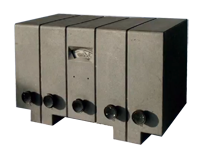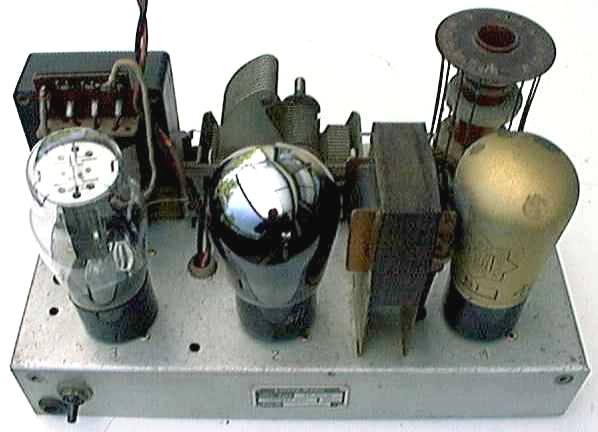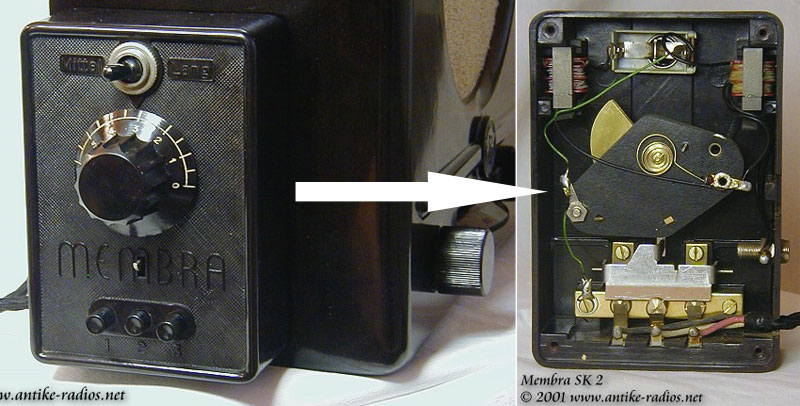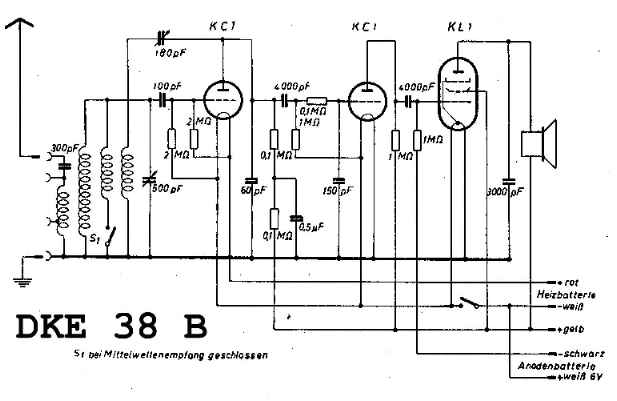WW2 German Radios
Old German Tube Radio: Volks-Empfenger
 The People’s Radio (German Volksempfänger, Volks-Empfenger) is a unique, unparalleled program launched in Germany in 1933. We are talking about the manufacture of completely identical radios by different firms on the basis of a single design documentation and using the same parts and assemblies. Volksempfänger should have allowed every family to listen to the radio. The device cost 76 Reichsmarks - despite the fact that the regular price of the then radio receiver was about 400 Reichsmarks.
The People’s Radio (German Volksempfänger, Volks-Empfenger) is a unique, unparalleled program launched in Germany in 1933. We are talking about the manufacture of completely identical radios by different firms on the basis of a single design documentation and using the same parts and assemblies. Volksempfänger should have allowed every family to listen to the radio. The device cost 76 Reichsmarks - despite the fact that the regular price of the then radio receiver was about 400 Reichsmarks.
Adolf Hitler (called "Führer") ordered shortly after his rise to power in 1933, German radio manufacturers to produce the Volksempfaenger "People's Receiver" named VE301 as an inexpensive, means to give every German family access to the Nazi Party's Radio broadcasts, to ensure that the Nazi propaganda machine was able to transmit to all homes. The name VE301 was taken to remind at the 30.1.1933 day of Adolf Hitler's rise to power ("Volksempfänger der Nationalsozialistischen Revolution am 30.1.1933").
The first model, was the Volksempfanger model VE301. The cabinet was designed by Walter Maria Kersting, a well known German architect, which has a hybridised art deco styling, merged with German gothic.The "gothic" being the arch-like styling of the tuning dial.
The actual chassis was designed by Otto Griessing, the Chief Engineer, (Oberingenieur), for the electronics company of Seibt.
The first VE set was certainly innovative, but lacking in quality. This prompted further developments, before finally being abandoned in 1938 for the smaller VE301 DYN. This set was available in AC/AC-DC formats, and was technically much better over the earlier VE301. Also at this time, the even smaller Deutscher Kleinempfanger - DKE was released to the public, and this set actually continued into production to as late as 1950 (without political logo).
 Another set worthy of mention was the "Deutscher Arbeitsfrontempfanger", known simply as the DAF1011. This set was produced mainly for factories, and was intended for workers to whistle while they worked to nazi propaganda songs, political speeches, and classical music. Unlike the other political receivers, this set had no inbuilt speaker, and was intended to be connected through the workplace speaker set-up. Stylishly deco, in a metallic or bakelite cabinet, but very much monolithic in style.
Another set worthy of mention was the "Deutscher Arbeitsfrontempfanger", known simply as the DAF1011. This set was produced mainly for factories, and was intended for workers to whistle while they worked to nazi propaganda songs, political speeches, and classical music. Unlike the other political receivers, this set had no inbuilt speaker, and was intended to be connected through the workplace speaker set-up. Stylishly deco, in a metallic or bakelite cabinet, but very much monolithic in style.
These sets were built by various manufacturers. All manufacturers organized in the WDRI could or had to produce Volksempfangers. The following list shows the German and Austrian (then Ostmark) members of the WDRI. The particular manufacturer usually is indicated on the back cover or on the chassis:
AEG, Braun, Blaupunkt, Brandt, DeTeWe, Dietz & Ritter (Koerting), Emud (Maestling), Eumig, Graetz, Hagenuck (Nordmark) (Neufeld & Kuhnke), Horney, Ingelen, Kapsch, Koch & Sterzel, Lange , Loewe (Radio A.G.), Lorenz , Lumophon (Bruckner u. Stark), Mende, Minerva, Nora, Owin, Philips, Radio-Funk-Werkstaetten (Grassmann), Radione, Reico, Rundfunktechnische Erzeugergemeinschaft (Gemeinschaftserzeugnis), Rundfunktechnische Fabrik (Eltz), Saba, Sachsenwerk, Schaleco, Schaub, Seibt, Siemens, Stassfurt, Tefag, TeKaDe, Telefunken, Telefunken Warschau, Valvo Radioroehren GMBH, Wega, Zerdik.
Until 1937, approx. 2.6 million Volksempfangers were sold. Here some production data 1939-1943:
| Year | Brand name receivers | Volksempfanger | DKE | Total |
|---|---|---|---|---|
| 1939 | 1785000 | 64800 | 553000 | 2986000 |
| 1940 | 700000 | 188000 | 496000 | 1384000 |
| 1941 | 415000 | 18000 | 421000 | 854000 |
| 1942 | 580000 | 4000 | 193000 | 777000 |
| 1943 | 538000 | 0 | 186000 | 723000 |
When you want to buy a Volksempfanger: Pay attention to agreement of the manufacturers label on the chassis and the back panel. There are many "people receivers" where there is disagreement on this count.
Receiver performance. It is maintained again and again the people receivers could only receive the local broadcast station were very insensitive. That´s not right. Reception of European stations (receiver location Germany) was often possible during night. Even today the receiver performes quite well. Here a test certificate of the German periodical "Funktechnik", 1938.
|
DKE
|
VE301W
|
VE301Wn
|
|
|
Sensitivity
|
1,0 mV
|
1,5mV
|
0,5mV!
|
|
Selectivity
|
3%
|
7%
|
3%
|
|
Power consumption
|
15 watts
|
21 watts
|
21 watts
|
Main characteristics of receivers:
| Types: | Manufactured: | Price: | Tube assembly: | Output power: |
|---|---|---|---|---|
| VE301 W | zw. 1933-1937 | 76,- RM | REN904, RES164, RGN354 | 0,8 Watt |
| VE301 G | zw. 1933-1935 | 76,- / 65,- RM | RE1821, RENS1823d | 1,7 Watt |
| VE301 GW | zw. 1935-1939 | 87,- RM | VC1, VL1, VY1 | 1,5 Watt |
| VE301 Wn | nur 1937 / ab 1940 | 65,- RM | AF7, RES164, RGN354 | 0,8 Watt |
| VE301 Dyn W | ab 1938 | 65,- RM | AF7, RES164, RGN1064 | 1,2 Watt |
| VE301 Dyn GW | ab 1939 | 74,50 RM | VF7, VL1, VY1 | 1,6 Watt |
| VE301 B | zw. 1933-1934 | 65,- RM | RE034, RE034, RES174d | 1,3 Watt |
| VE301 B2 | ab 1934 | 65,- RM | KC1, KC1, KL1 | 0,4 Watt |
| DKE 1938 | ab 1938 | 35,- RM | VCL11, VY2 | 0,8 Watt |
| DKE 1938 B | ab 1939 | 32,50 RM | KC1, KC1, KL1 | 0,4 Watt |
Vacuum tubes for German military radios
Volks Empfänger VE301

Tubes (1937 - 1940): AF7, RES164, RGN354 |

|

|
Nora VE301dyn GW
VE301dyn GW with shortwave addition plugged into the base of the VF7 and connected to the coil. With the small lever on the bottom right was switched to shortwave. For the addition, a hole had to be cut in the rear wall for the antenna sockets and the switch.
Tubes from left to right VY1, VL1, VF7. Behind the VY1 is the Urdox 3505.

|

|

|
Deutscher Klein Empfänger DKE

|

|
This most popular of Volksempfängers was the small regenerative receiver DKE produced 1938, as the second and cheapest of the tree different VE models, in the year before WW ll and cost only 35 RM or 32,50 Reichs Mark as battery receiver. It was identical in operating principle to it's larger brothers but was physically much simpler, built with parts specially designed for this receiver - like speaker and even it's two tubes VCL11 and VY2.
The all-power supply of the DKE allows the operation of the device both on AC and DC voltage. To this a special tube was developed specifically for the DKE, the VCL 11. This tube, together with the VY 2, formed the tube technical conditions for all-stream operation and to simplify the circuit complexity.
The VCL 11 requires a heating voltage of 90 volts, the VY 2 of 30 volts. As with all-stream receivers, the heaters of all tubes be connected in series, the total heating voltage of the two DKE tubes is thus 120 volts, which is the direct operation on 110 volt network made practically possible. The operation on the 150 or 220 volt network was to be switched by means of a corresponding resistances are put into action (as is still the case today).
Very interesting is also the wiring of the VCL 11. Both tube systems (C = triode, L = pentode) are characterized by a connected to each other. Thus, in addition to its function as a lattice rectifier, the triode system is able to drive the pentode output stage without the use of a transmission transformer.
The special thing about this radio is that it is a single-circuit receiver with feedback that works around 1 tube, namely the VCL11. The left control is for the antenna coupling on the coil set that controls the volume, while the right control determines the feedback. The feedback should be set so that it is on the verge of oscillating. The middle dial is the final tuning. The scale goes from 0-100, of which the white numbers are the MG and the red numbers indicate the LG. The switching is done automatically by a contact that is either open or closed for 180°. The volume goes up to room volume. This is followed by the howling sound that is typical of feedback receivers. The speaker has a hard cardboard frame that is quite sturdy. The loudspeaker is a very high-impedance type of around 17 KOhm and is directly in the anode line of the end tetrode. The speaker magnet is a U-shaped permanent magnet. The speaker in the photo is a type with an electromagnet. The reception is fine and reasonably sensitive, but you need a solid antenna signal and good ground to be able to receive distant foreign channels.
Additional VE parts

All models VE 301 had a single resonant input circuit. However, the circuit of the input circuits made it possible to increase the selectivity due to external devices, for connection of which a special 8-pin connector was provided on the left wall of the VE 301.
It must be said that a whole industry of various accessories arose very quickly around "People's Receivers". They were engaged in the production of both well-known companies and small companies whose names now will not tell anyone anything.
For the VE 301, not only additional circuits for increasing selectivity were produced, but also antenna switches, scale illumination, filters to reduce electrical noise, etc.
Circling circuits were used to improve the selectivity of the simple receivers, hide the strong local transmitters (since otherwise no other station could be received) and also to receive weak transmitters (mostly banned foreign stations) which were lost in the "Wellensalat" or deliberately disturbed.

Who was not satisfied with the simple design of the people receiver or the limited usability, could hereby remedy itself. Some companies offered interesting additional components for self-assembly, with which easily the cheap community receiver pieces could be upgraded for each piece. This ranged from the simple barrier circuit on additional scales to special attachments with which some Models could be upgraded to two-wire and even to a powerful superheterphone receiver...

For attachment to the VE housing, the SK 2 has a large metal clamp on the back; so that the blocking circuit is like a paper clip pushed onto the side wall of the receiver.
Add comment:
| Name: | ||
| code protection:* | ||
| email:* | ||



 Main
Main